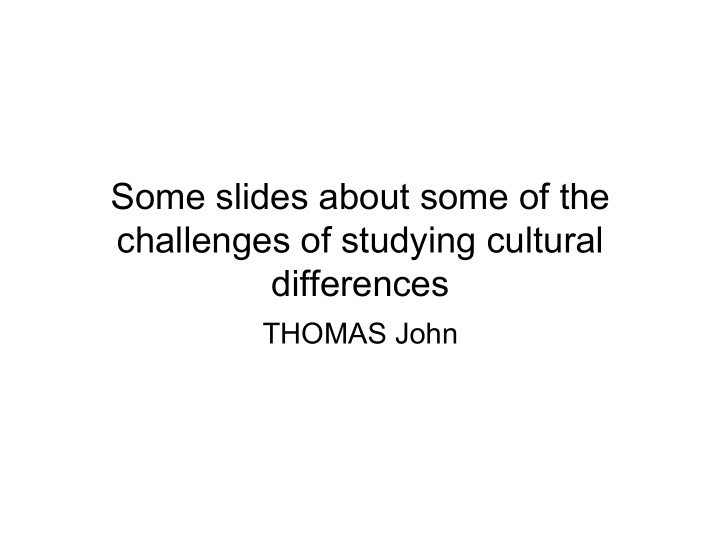



Some slides about some of the challenges of studying cultural differences THOMAS John
(Some) Possible Confounding Factors: • Recruiting in two different places may result in different sampling biases. (Course credit vs. money only one of many possible differences). • Recruiting in the same place means it’s “different” too. • Two different physical set-ups may result in different behavior (color, shape, atmosphere, etc.) --- but same set up may be “different.” • Two different sets of experimenters may result in different behavior. • Translation of instructions may not result in “behaviorally equivalent” expectations. • Weather/Climate/External events may influence behavior. • Subject’s interpretation of scales may be different in different cultures; e.g., some may find “extreme ratings” to be a good thing to do; others, a negative. • Different diets, exercise patterns, medical practices may lead to different physical states. • Different languages may be better or worse suited for particular tasks. • Do you try to make “objective reality” the same or use Piagetian clinical technique? (His technique was to do different things with different children in order to reach the “same” state.)
Other (really hard) Problems • Not clear that culture can be “dimensionalized”; perhaps more like chemistry, or an organism; that is, feedback loops to preserve goals trumps means • Culture as variable or Person as variable? • Prescription or Adaptation? • Risk (as in gender, age, race) research of the “excuse for prejudice” interpretation. • Culture is a moving target. • Culture seems to be as complex as, say, the plant kingdom – infinite regress – Example: American Culture; traditional clothing, eating, recreation, etc.
American Culture: Traditional Garb ?
American Culture: Traditional Eating ?
American Traditional Recreation ?
American Culture? • Are we studying American Culture... • Or, are we studying one specific American sub- Culture of “being in a psychological experiment”? • And, if so, what relationship does it have to the culture of Ballroom dancing, dirt bike racing, cheeseheads, golf, etc? • Might these be more powerful predictors of behavior and the design of tools? • Perhaps “American Culture” is the anomaly?
UK: “Traditional” Weddings Not just a US phenomenon.
USA/W. Europe “Hierarchy of Cultures”??? USA California “The 4 pm invitation” Midwest Bikers Surfers Berkeley Radicals
Explanation of “4 pm invitation” • My wife is originally from California and I’m originally from the MidWest. • I got a call from my brother’s sister’s sister to come over at 4 pm (16:00). • I said thanks and then my wife said, “Are we invited for dinner?” • I said I had no idea. I suggested we eat a little before going over so we could eat dinner if served but would not be too hungry if not served. • She said we should call them back and ask. • I thought this was completely inappropriate! • If you call someone and ask whether you are invited for dinner, this implies that you should have been. NOT a Midwestern thing to do. • But my wife thought this was a perfectly reasonable and acceptable thing to do. • Even regional (and generational) differences in what is “culturally appropriate” vary a lot within one country.
“Dimensions” of Culture ????
“Sprays of Culture”????
Culture changes “Position”, “Size”, “Color”, etc. over time. Measure HERE; but apply in the FUTURE Time
Valuable Outcomes • Gain deeper understanding like stereoscopic vision of one’s own cultural context. • Gain deeper understanding of what is fundamental. • Practical benefits: systems that enhance collective human communication and intelligence. • Time critical? Loss of cultural differences or replacement with transnational cultures like WoW?
Differences non-trivial • Desert Survival – Americans and Chinese were equally diverse in first round; after discussion, Americans moved a tiny amount and Chinese were almost completely in agreement • Games in second life – Chinese users were much more aware of the fact that people were from different cultures
Recommend
More recommend